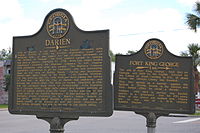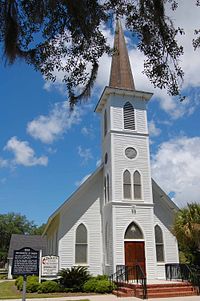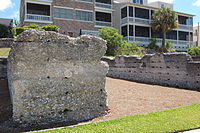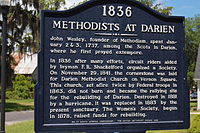- Darien, Georgia
-
Darien, Georgia — City — Darien riverfront skyline Location in McIntosh County and the state of Georgia Coordinates: 31°22′16″N 81°25′51″W / 31.37111°N 81.43083°WCoordinates: 31°22′16″N 81°25′51″W / 31.37111°N 81.43083°W Country United States State Georgia County McIntosh Area - Total 2 sq mi (5.1 km2) - Land 2 sq mi (5.1 km2) - Water 0 sq mi (0 km2) Elevation 30 ft (9 m) Population (2000) - Total 1,719 - Density 859.5/sq mi (337.1/km2) Time zone Eastern (EST) (UTC-5) - Summer (DST) EDT (UTC-4) ZIP code 31305 Area code(s) 912 FIPS code 13-21716[1] GNIS feature ID 0331512[2] Darien is a city in McIntosh County, Georgia, United States. It lies on Georgia's coast at the mouth of the Altamaha River about 50 miles south of Savannah, and is part of the Brunswick, Georgia Metropolitan Statistical Area. The population of Darien was 1,719 at the 2000 census. The city is the county seat of McIntosh County[3]. It is the second oldest planned city in Georgia and was originally called New Inverness.
Contents
Geography
Darien is located at 31°22′16″N 81°25′51″W / 31.37111°N 81.43083°W (31.371134, −81.430742)[4].
According to the United States Census Bureau, the city has a total area of 2.0 square miles (5.2 km2), all of it land.
Demographics
As of the census[1] of 2000, there were 1,719 people, 697 households, and 464 families residing in the city. The population density was 869.6 people per square mile (335.2/km²). There were 832 housing units at an average density of 420.9 per square mile (162.2/km²). The racial makeup of the city was 54.10% White, 43.98% African American, 0.12% Native American, 0.64% Asian, 0.17% Pacific Islander, 0.06% from other races, and 0.93% from two or more races. Hispanic or Latino of any race were 0.64% of the population.
There were 697 households out of which 30.6% had children under the age of 18 living with them, 42.8% were married couples living together, 18.8% had a female householder with no husband present, and 33.4% were non-families. 30.6% of all households were made up of individuals and 13.2% had someone living alone who was 65 years of age or older. The average household size was 2.47 and the average family size was 3.06.
In the city the population was spread out with 29.2% under the age of 18, 7.5% from 18 to 24, 25.4% from 25 to 44, 23.5% from 45 to 64, and 14.4% who were 65 years of age or older. The median age was 37 years. For every 100 females there were 82.5 males. For every 100 females age 18 and over, there were 80.3 males.
The median income for a household in the city was $24,135, and the median income for a family was $28,750. Males had a median income of $26,198 versus $16,897 for females. The per capita income for the city was $11,938. About 21.3% of families and 24.7% of the population were below the poverty line, including 29.8% of those under age 18 and 25.2% of those age 65 or over.
History
Settlement of Darien
Fort King George (Georgia's oldest fort) was built in 1721, near what would become Darien. At the time it was the southern-most outpost of the British Empire in North America. The fort was abandoned in 1727 following attacks from the Spanish.
The town of Darien (originally known as New Inverness) was founded in January 1736 by Scottish Highlanders recruited by James Oglethorpe to act as settler-soldiers protecting the frontiers of Georgia from the Spanish in Florida, the French in the Alabama basin and their Indian allies. On 10 January 1736, 177 emigrants, including women and children, arrived on board the Prince of Wales to establish Darien, which was named after the Darien Scheme, a former Scottish colony in Panama. Among the initial settlers was Lachlan McGillivray, the Indian trader, and Lachlan McIntosh, the revolutionary leader. The Scots originated mainly from around Inverness and consisted of both Jacobite and Hanoverian supporting clans, the majority of whom spoke only Gaelic. When visited by Oglethorpe in February the settlers had already constructed "a battery of four pieces of cannon, built a guardhouse, a storehouse, a chapel, and several huts for particular people".
They showed similar progress in the construction of military forts, by March the Scottish settlers had begun work on two forts, Fort St. Andrews on Cumberland Island, and Fort St. George on the St. Johns River 60 miles to the south of the territory claimed by the British government in the charter of the Georgia colony. Fort St. George was later abandoned after agreement with the Spanish in October 1736. In 1736 work was also begun on Fort Frederica, which is on St. Simons Island, a few miles south of Darien, between Darien and Cumberland Island. As the Scots were intended as a military force those settlers whose travel was paid for by the Trustees of the Colony were organized into two companies, the Highland Independent Company of Foot, an infantry force, and the Highland Rangers, a mounted force. By 1737 the constant military activity of the Darien colony was taking its toll and an additional forty-four Highland settlers arrived to expand the town.
Initially the settlers' economy was based on the cultivation of crops; however, after the first year they experienced a succession of poor harvests and concentrated more on the rearing of cattle and the felling of timber for sale in nearby Savannah.
In 1739 eighteen of the most prominent members of the Darien colony signed the first petition against the introduction of slavery into Georgia. This was in response to pleas to Oglethorpe and the Trustees by inhabitants of Savannah to lift their prohibition on slavery. The Highlanders' petition was successful and slavery was not introduced until ten years later in 1749.
A constant state of conflict continued with Spanish and Indian forces during this time. However, it did not grow beyond the level of occasional skirmishes until the onset of the War of Jenkins' Ear in October 1739. In November in response to the death of two Scots garrisoned on Amelia Island from an ambush by Spanish allied Indians the Darien settlers mobilized and together with forces from South Carolina captured the Spanish forts of Fort Picolata, Fort St. Francis de Pupo, Fort San Diego and Fort Mosa before attempting to lay siege to St. Augustine. The subsequent Battle of Fort Mosa resulted in the death or capture of fifty-one of the Darien settlers.
After the battle a number of the settlers abandoned Darien for South Carolina and by 1741 another shipload of forty-three colonists had arrived. These colonists received land grants from the Trustees which specified that the land was to descend to the male or female descendants of the original recipients, in 'Tail General', this was a unique change as previously, with a few specific exceptions in Darien, all land grants in the American colonies had been granted in 'Tail Male', descending to the male children. This had caused great discontent among the Highland Settlers as it went against their traditional land holding and inheritance practices. In future the majority of Georgia land grants were made in 'Tail General'.
Civil War and after
On 11 June 1863, Federal troops stationed on St. Simons Island looted and then destroyed most of the town, including the homes of the black residents/slaves. (This was not part of Sherman's March to the Sea, which occurred more than a year later. Confusion has arisen because the St. Simons Island troops were under the command of another General Sherman, stationed in the South Carolina Sea Islands). The destruction of this undefended city, which was of little strategic importance, was carried out by the 54th Massachusetts Volunteers under the command of a reluctant Colonel Robert Gould Shaw (who would later call the raid a "Satanic Action") and the 2nd South Carolina Volunteers under the command of Colonel James Montgomery. Colonel Montgomery ordered that the town be looted and then burned. Montgomery's troops broke ranks and looted freely, while Shaw ordered his to take only that which would be useful at camp. The First African Baptist Church (the oldest African-American church in the county) was destroyed along with the rest of the town. It was rebuilt and later some meetings of the Civil rights movement were held there.
After the U.S. Army invaded McIntosh County and destroyed Darien, gunboats were used to blockade the ports. These personnel constantly plundered McIntosh County. The only defense to the plundering that the county had was a group of men too old for military service. On the night of 3 August 1864, the county's elderly defenders had met at the Ebenezer Church, nine miles north of Darien. Federal troops found out about the meeting from local informants. The troops surrounded the church, opened fire, and captured twenty-three old men. These civilians were marched to a landing near Darien and put on ships and taken to prisons in the North.
Following the Civil War, Darien was rebuilt, with financial aid coming in small part from the family of Colonel Robert Gould Shaw, who had been killed during the War but had written of his shame in participating in the destruction.[5]
Into the early 1900s, Darien was one of the largest ports for shipping lumber. When the timber was depleted, Darien became a fishing village, primarily for Georgia wild shrimp. It was once famous for its oysters.
There are thirty-two markers of historic sites near Darien and forty-two markers in McIntosh County. (See the external link for a list.)
Darien in the 21st century has once again shown signs of growth as it did in the period prior to the Civil War. In an effort to change with the time the City has changed its form of government to council/manager and has hired the first City Manager in Darien or McIntosh County. With the formation of the Interstate Highway System, Interstate 95 was constructed and passes approximately a mile west of the city. This in turn caused development near the I-95 interchange with GA-251, where there are now several chain restaurants, gas stations, and hotels. Downtown Darien has flourished as well and many new businesses have opened due to the proximity to the waterfront.
Education
McIntosh County School District
The McIntosh County School District holds grades pre-school to grade twelve, that consists of two elementary schools, a middle school, and a high school.[6] The district has 121 full-time teachers and over 1,979 students.[7]
- Oak Grove Intermediate School
- Todd Grant Elementary School
- McIntosh County Middle School
- McIntosh County Academy
References
- ^ a b "American FactFinder". United States Census Bureau. http://factfinder.census.gov. Retrieved 2008-01-31.
- ^ "US Board on Geographic Names". United States Geological Survey. 2007-10-25. http://geonames.usgs.gov. Retrieved 2008-01-31.
- ^ "Find a County". National Association of Counties. http://www.naco.org/Counties/Pages/FindACounty.aspx. Retrieved 2011-06-07.
- ^ "US Gazetteer files: 2010, 2000, and 1990". United States Census Bureau. 2011-02-12. http://www.census.gov/geo/www/gazetteer/gazette.html. Retrieved 2011-04-23.
- ^ Burchard, Peter. One Gallant Rush p.151
- ^ Georgia Board of Education, Retrieved 24 June 2010.
- ^ School Stats, Retrieved 24 June 2010.
Further reading
- Burchard, Peter (1965) One Gallant Rush St. Martin's Press, New York, NY;
- Parker, A.W. (1997) Scottish Highlanders in Colonial Georgia, The Recruitment, Emigration and Settlement at Darien, 1735–1748 University of Georgia Press, Athens, GA, ISBN 0-8203-1915-5 ;
- Sullivan, Buddy, ed. The Darien Journal of John Girardeau Legare, Ricegrower (University of Georgia Press; 2010). 168 pages. Edition of a journal kept by a South Carolinian who arrived in Darien in 1877 and managed rice plantations; documents the gradual decline of rice cultivation in Tidewater Georgia and the rise of the timber industry.
External links
- Official website of the City of Darien, Georgia
- Georgia's Coast in photographs and more
- sherpa guide Midway/Darien
- Sherpa Guide, Darien
- Fort King George
- Videos of Fort King George "Debatable Lands" Encampment & Battle Reenactment
- Historical markers in MacIntosh County
- The burning of Darien
- 23 old men
- Georgia Magazine
Municipalities and communities of McIntosh County, Georgia County seat: Darien City Darien
Unincorporated
communitiesCategories:- Cities in Georgia (U.S. state)
- Populated places in McIntosh County, Georgia
- County seats in Georgia (U.S. state)
- Brunswick metropolitan area
Wikimedia Foundation. 2010.











